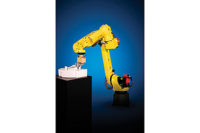Automotive Lighting Corp. (Juarez, Mexico) needed a machine to ultrasonically weld plastic lens-and-reflector assemblies. Initial designers envisioned a nine-headed welding unit. However, the concept was rejected, because the unit would have been difficult to align and limited to welding similar assemblies. It would also have been difficult to build because of size constraints and interference problems.
As a result, Automotive Lighting installed a workcell, designed and built by Dukane Corp. (St. Charles, IL), that included a six-axis robotic arm to take the place of nine pneumatic thrusters. Dukane was able to build the manufacturing cell in less time than it would have taken to create a conventional multihead system. According to Automotive Lighting Corp., the cost was slightly higher, but comparable.
The welding arm is both accurate and flexible, capable of performing welds on a variety of different subassemblies. The system uses a "smart" fixturing system, which determines whether the subassembly being welded is a left- or right-hand unit. It then selects the correct welding path for the robot to follow and adjusts the welding pressure at each weld tab.
The ultrasonic generator monitors the weld time and energy, using Dukane's sequencing technology to ensure each value is within specifications.
As new subassembly designs are produced, the only changes required for performing the necessary welds are new fixturing and a new weld-path parameters program.
For more on welding plastics, call 630-797-4900, visit www.dukcorp.com/us or eInquiry 6.
